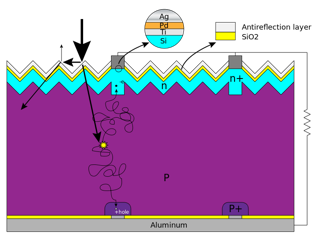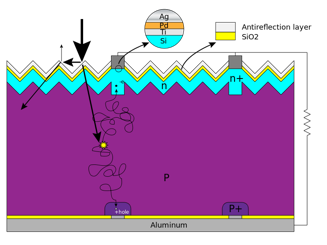Solar cells are multiple panel-conductor-electrode systems which, when joined with several others, can generate a tangible and significant amount of electrical current. There are three main types of solar cells, which differ primarily in the material used for the semiconductor and electrode. The process occurs in two main steps: a collection of sunlight using solar panels and a conversion of the energy present in the rays into electricity. Solar panels focus sunray into a high-energy photon beam using mirrors and angled lenses. This light is then directed at a length of metal or silicon- or selenium-based semiconductor. As the photon collides with the metal or semiconductor, electrons are excited from their ground state orbitals. The electrons either fall back into their ground states, dissipating the energy as heat, which is not preferred, or travel through the material towards an electrode. The motion of negatively-charged electrons generates a current in the semiconductor.
The sections below cover two different types of solar cells. These sections cover general information, equipment design, and advantages/disadvantages.
Silicon Solar Cells

General Information
Monocrystalline Silicon Solar Cells
Monocrystalline silicon is made from silicon ingots that have been processed to form a single, large crystal. Raw silicon undergoes the Czochralski process, which cultivates a single large crystal from melted silicon through the use of a seed crystal and maneuvering of the growing crystal, often by spinning the crystal as it is drawn through the liquid silicon. This material has the highest solar-to-electricity conversion efficiency and consequently the best space efficiency, but they are the most expensive to manufacture and can decrease in efficiency in colder weather. Costs may vary frequently due to the dependence on manufacturing costs and materials costs for silicon, iron, and glass.
Polycrystalline Silicon Solar Cells
Polycrystalline silicon is composed of multiple small coagulated crystals and still functions through the same mechanism as monocrystalline silicon, albeit at different efficiency. The cost of manufacturing is much lower and they are slightly more weather-resistant than monocrystalline silicon. Polycrystalline silicon cells are not as efficient as monocrystalline silicon cells but have shown the highest light absorption potential, therefore they may be more efficient in the future if losses due to electrical irregularities can be minimized.
Equipment Design
There are many configurations of solar cells on the market to perform a range of possible functions. It is imperative that solar cells remain cost-effective, regardless of the lower conversion efficiency of sunlight to electricity. Commercial solar photovoltaic panels are composed of many solar cells combined under a sheet of glass, which protects the silicon crystals, or wafers. The solar cells may be connected in parallel to yield a higher current in the circuit, thus creating a higher additive voltage effect. The combined solar cells in the solar photovoltaic panel can then transfer the energy from the sun to direct current (DC) electricity, or, with the use of an inverter, to alternating current (AC) electricity.
Advantages
- Very long lifespan (~30 years)
- Can be seamlessly integrated into a building’s roofing
- Can cover a majority of energy needs for an average home
- Government policies might allow homeowners to make money when they send energy back to the electrical grid
Disadvantages
- Very expensive initial investment
- Requires a significant amount of space to generate a lot of electricity
- Not practical for supplying all of a household’s energy needs
Amorphous Solar Cells

General Information
Amorphous, or thin-film cells, involve coating a surface, such as glass, a cheap metal, or other material, with the metal/semiconductor. The semiconductor, generally silicon or some combination of two or more of silicon, cadmium, telluride, indium, selenide, copper, and gallium, is laid in thin sheets on the surface and functions under the same mechanism described above. These are the cheapest and easiest type of solar cells to mass-produce, but they have an extremely poor space efficiency compared to the monocrystalline and polycrystalline cells. These cells have been used far less than mono- or polycrystalline silicon cells due to the relatively high cost of all three technologies and the fact that the thin-film cells have the lowest efficiency.
Equipment Design
Since thin-film solar cells can be produced to be a flexible material, they can be placed almost anywhere, making them ideal for building with solar cells. The same principles as other solar cells apply in that the energy absorbed in thin-film solar cells is converted to DC electricity, or AC electricity with the use of an inverter. Thin-film solar cells are often wired in series if multiple layers are desired for greater sunlight absorption, and then in parallel to maximize current, and thus the additive resulting voltage.
Advantages
- Can be placed on many surfaces, including vehicles or building facings
- Can be made semi-transparent to be used inside of window panes
- Easier to install than rigid photovoltaic panels
- More opportunities to use for different purposes than bulkier solar energy technology
Disadvantages
- Very expensive initial investment
- Lowest sunlight conversion efficiency of all solar cells
- Need many in a configuration to capture any significant amount of electricity
- Lowest spatial efficiency of all solar energy technology
References
- L. Richardson, “Thin Film Solar Panels: Do They Make Sense? | EnergySage”, Solar News, 2018. [Online]. Available: https://news.energysage.com/thin-film-solar-panels-make-sense/. [Accessed: 01- Nov- 2018].
- J. Kim, K. Kim, S. Hwan Ko and W. Kim, “Optimum design of ordered bulk heterojunction organic photovoltaics”, Solar Energy Materials and Solar Cells, vol. 95, no. 11, pp. 3021-3024, 2011.
- J. Yoo and Hyun-jun Soh and H. Soh, “Designing an optimal absorbing layer for thin-film solar cells”, Spie.org, 2012. [Online]. Available: http://spie.org/newsroom/4376-designing-an-optimal-absorbing-layer-for-thin-film-solar-cells?ArticleID=&SSO=1. [Accessed: 15- Jul- 2018].
- Ohmukai, M. and Tsuyoshi, A. (2017) Comparison between Amorphous and Tandem Silicon Solar Cells in Practical Use. Journal of Power and Energy Engineering, 5, 9-14. doi: 10.4236/jpee.2017.54002 .
Acknowledgements
- U.S. Department of the Interior, Bureau of Reclamation, Boulder City, Nevada.
- Prof. Andrej Lenert, University of Michigan Chemical Engineering Department
Developers
- Nuramani Saiyidah Binti Ramli
- James Rivard
- Emma TerBeek

